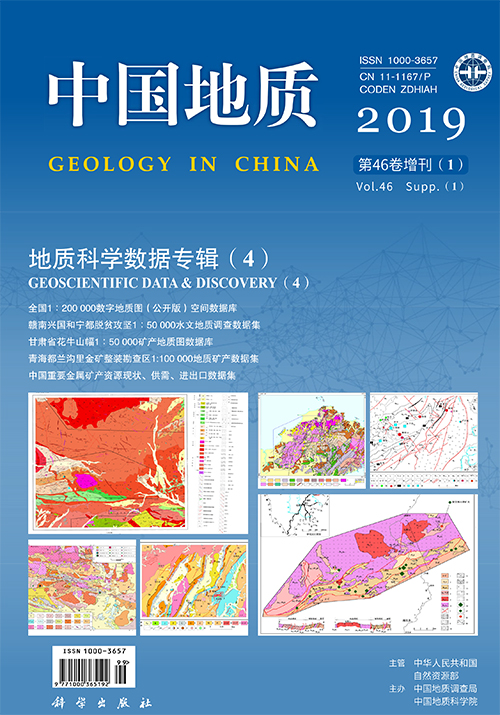| Citation: | ZHAO Liqun, ZHANG Min, CHEN Tong. 2019. Dataset of Present Status, Supply and Demand, and Import-Export Volume of Important Metal Mineral Resources in China[J]. Geology in China, 46(S1): 105-109. doi: 10.12029/gc2019Z112 |
Dataset of Present Status, Supply and Demand, and Import-Export Volume of Important Metal Mineral Resources in China
-
Abstract
Metal mineral resources serve as the material basis for economic and social development. In this paper, the data such as reserves, production and consumption of raw ore, as well as trade volume (including trade amount), of 16 kinds of metal mineral resources in the world and China from 2006 to 2017 that have an important impact on the economic development of China were collected. The 16 kinds of resources include bulk minerals in short supply (iron Fe, manganese Mn, copper Cu, aluminium Al, gold Au, lead Pb, zinc Zn, nickel Ni, and chromium Cr), dominant minerals (tungsten W, molybdenum Mo, tin Sn, and antimony Sb), and strategic emerging minerals (lithium Li, cobalt Co, and titanium Ti). The dataset consisting of the data collected is in Excel format and comprises six sheets (including Resources in the World, Identified Resource Reserves in China, Reserves Base in China, Raw Ore Production in China, Raw Ore Consumption in China, and Import-Export Volume of China), aiming to analyze the present status as well as the supply and demand trends of the important metal minerals required in the middle and late stages of the industrialization process of China. The following information is shown from the dataset. In terms of bulk minerals in short supply such as Fe, Mn, Cu, and Au, although identified resource reserves have increased steadily, the basic reserves have grown slowly due to the large volume of exploitation and consumption. With the total demand for bulk minerals in short supply still remaining high in the future, the import volume will continue to climb as a result of low resource guarantee degree in China. In terms of dominant minerals such as W and thorium (Th), they are no longer as dominant as before owing to low reserves-to-production ratio and insufficient backup resources. In terms of strategic emerging minerals including Li, Co and Ti, the resources and basic reserves have grown slowly or declined. The quality of these minerals in China is poor, making it difficult to utilize many of them. Moreover, the production and consumption of these minerals have grown rapidly in the past ten years and will continue to grow at a high rate in the future, whereas domestic reserves grow slowly, resulting in a prominent contradiction between supply and demand. The supply and demand data of the existing metal minerals are examined and summarized in this dataset, in order to provide references for exploration and strategic deployment of metal mineral resources in the future.
-
Keywords:
- Important metal minerals /
- Resources data /
- Supply and demand data /
- Trade data
-

-
References
[1] Wind. 万得数据库[DB/OL][2018-12-20]: http://www.wind.com.cn/. [2] 陈其慎, 于汶加, 张艳飞. 2016. 点石−未来20年全球矿产资源产业发展研究[M]. 北京: 科学出版社. [3] 马伟东. 2008. 金属矿产资源安全与发展战略研究[D]. 长沙: 中南大学. http://cdmd.cnki.com.cn/Article/CDMD-10533-2009214532.htm [4] 王安建, 王高尚, 陈其慎, 于汶加. 2010. 矿产资源需求理论与模型预测[J]. 地球学报, 31(2): 137−147. [5] 中国国家统计局. 矿石原矿产量[EB/OL][2018-12-20]: http://data.stats.gov.cn/easyquery.htm?cn=A01&zb=A020901&sj=201811. [6] 中华人民共和国海关总署. 进出口主要商品量值[EB/OL][2018-01-23]: http://www.customs.gov.cn/customs/302249/302274/302276/1421206/index.html. [1] Chen Qishen, Yu Wenjia, Zhang Yanfei. 2016. Ore Review-Research on the Development of Global Mineral Resources Industry in Future 20 Years[M]. Beijing: Science Press (in Chinese). [2] General Administration of Customs, P. R. China. Value and Quantity of Main Import and Export Commodities[EB/OL][2018-01-23]: http://www.customs.gov.cn/customs/302249/302274/302276/1421206/index.html. [3] Ma Weidong. 2008. Study on the Security and Development Strategy of Metal Mineral Resources[D]. Changsha: Central South University (in Chinese with English abstract). [4] National Bureau of Statistics of China. Ore Production[EB/OL]. [2018-12-20]: http://data.stats.gov.cn/easyquery.htm?cn=A01&zb=A020901&sj=201811. [5] Wang Anjian, Wang Gaoshang, Chen Qishen, Yu Wenjia. 2010. The Mineral Resources Demand Theory and the Prediction Model[J]. Acta Geoscientica Sinica, 31(2): 137−147 (in Chinese with English abstract). [6] Wind. Wind Database[DB/OL][2018-12-20]: shttp://www.wind.com.cn/. -
Access History





 DownLoad:
DownLoad: